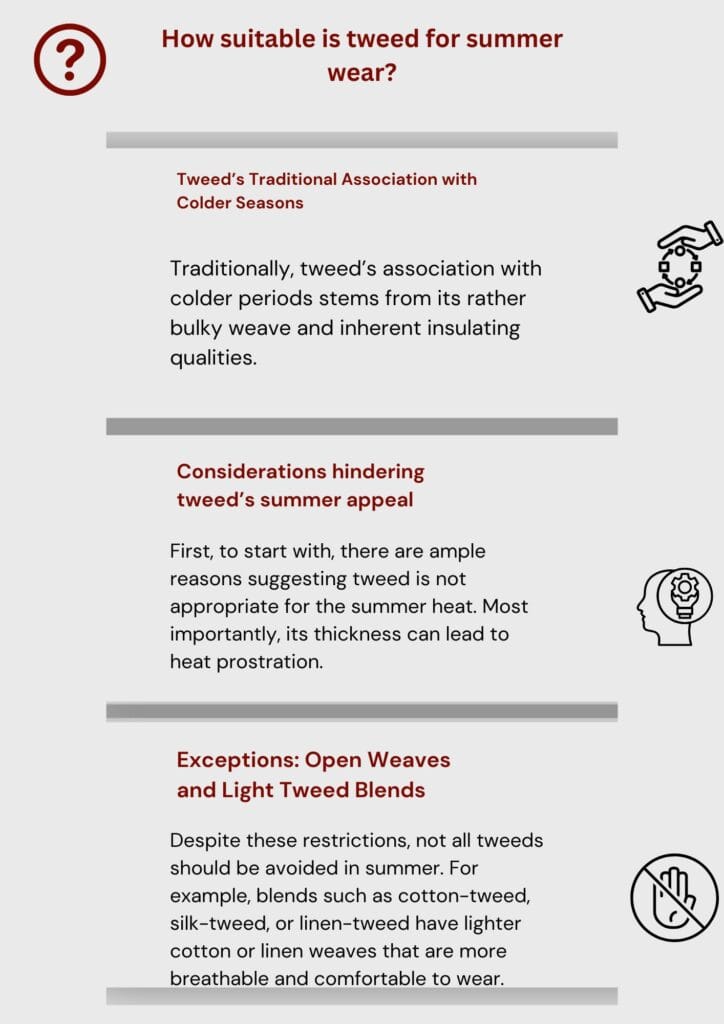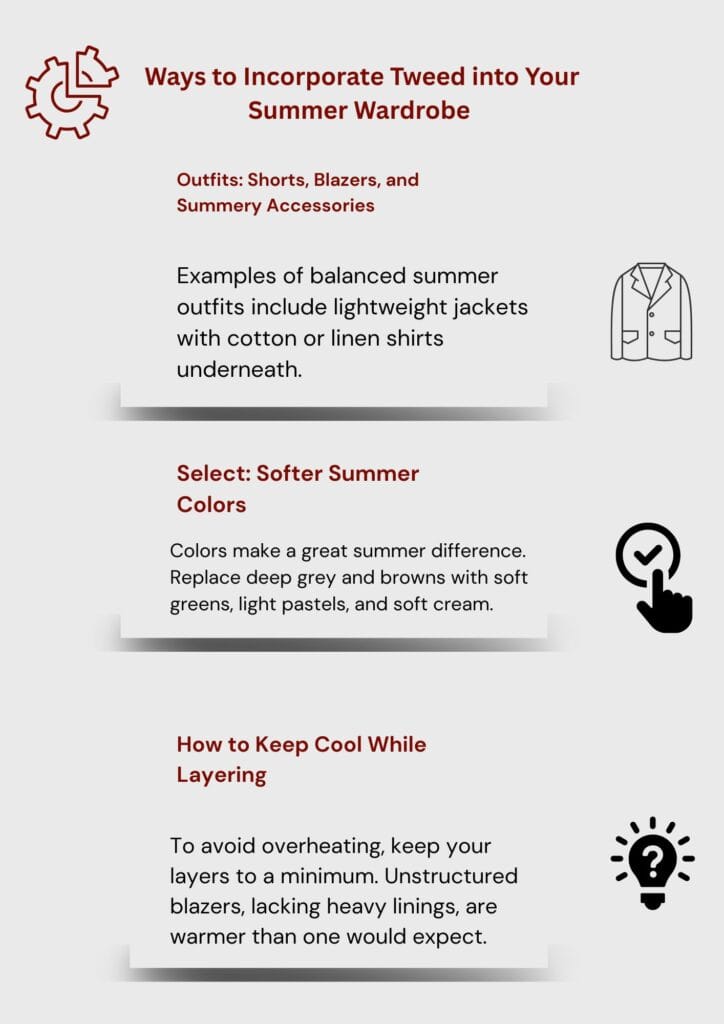Introduction
A Brief History and Origin of Tweed
Tweed is synonymous with British fashion. Its history dates back to the 18th century Scotland and Ireland, where it was first made as a rugged and handwoven woolen fabric. Farmers and outdoorsmen adopted it for its warmth and ruggedness in harsh climates. Tweed later became a staple of British Aristocracy and a hunting garment.
Today, tweed is often associated with traditions of old-world elegance and luxury. It is popularly known as cold-weather clothing, but one often wonders if it is a summer fabric. Looking into its history helps understand how it fits into modern seasonal wear.
Common Characteristics (Texture, Weight, Durability)
Tweed is easily recognized by its rough texture, weight, and patterns. It is made of carded wool and often features complex patterns like herringbone, twill, or even a plain weave. The fabric’s weight coupled with its durability makes it ideal for long-lasting garments.
Tweed restrains heat owing to its thick fibers and insulating properties. While this is ideal during winter months, the wearing of tweed during summer months raises questions. Newer fabric blends and lighter weights have made tweed more accessible to hotter climates.
Customary Applications (Suits, Jackets, Winter Apparel)
Formally, the fabric tweed was created for bespoke suits, blazers, caps and overcoats. This type of attire was especially ubiquitous for hunting, riding and country sports. Its popularity spread to urban cold regions where it became fashionable among scholars and politicians.
Now, we mostly see them worn in the autumn and winter months; however, of late, designers have been looking to add tweed to spring and summer wardrobes. With this change, the question that many are now asking is: Is tweed a summer fabric or should it remain seasonal?
How suitable is tweed for summer wear?

Tweed’s Traditional Association with Colder Seasons
Traditionally, tweed’s association with colder periods stems from its rather bulky weave and inherent insulating qualities. Moreover, its ability to retain heat made it is preferable in the British and Irish chills, thus, many consider it too hot for summer use.
Despite the changes in fashion being made every day, this steadfast reputation tweed has built over the years means that it will not be the first fabric that comes to mind for the warmer months.
Considerations hindering tweed’s summer appeal
First, to start with, there are ample reasons suggesting tweed is not appropriate for the summer heat. Most importantly, its thickness can lead to heat prostration. כגון , the lack of breathability and heavy weight makes traditional tweed unbearable in humid or hot conditions.
Whereas most fabrics utilize wicking as a means of moisture control, wool does the exact opposite by absorbing moisture. This can cause discomfort, skin irritation, and even sweat stains. Therefore, while wool tweed is considered stylish, it is not practical in terms of comfort during hot weather.
Exceptions: Open Weaves and Light Tweed Blends
Despite these restrictions, not all tweeds should be avoided in summer. For example, blends such as cotton-tweed, silk-tweed, or linen-tweed have lighter cotton or linen weaves that are more breathable and comfortable to wear. These fabrics are characterized by open weaves.
Tailors have started offering elegant summer tweed collections that maintain the formality of the fabric while allowing for seasonal flexibility. In these circumstances, the answer to the question is tweed a summer fabric becomes a resounding yes.
Lightweight Tweed Alternatives for Summer
Categories of Summer-Friendly Tweed: Linen-Tweed, Silk-Tweed, Cotton-Tweed
Summer-friendly tweed refers to lighter fabrics that shift the seasonal applicability of tweed. Linen-tweed blends are summer friendly and ideal for hot weather. They are cool to the skin and retain the elegance of traditional tweed.
Tweed enthusiasts get to keep their semblance but without the heat courtesy of silk-tweed which adds a luxurious touch, and cotton-tweed which is a soft, more breathable alternative. Summer tweeds blends include silk-tweed and cotton tweed.
Summer and Winter Collections by Other Brands
Many contemporary brands have started producing summer tweed garments. J.Crew, Hackett, Brooks Brothers, and Harris Tweed have all embraced summer versatility, designing summer-friendly garments like blazers, vests, and accessories.
Look for garments advertised as “lightweight tweed” or, “summer tweed” to avoid excess warmth. The tweeds designed for summer wear are pulled from the lightest fabrics in a temperature and insulation sense.
Breathability and Comfort Comparisons
Summer twedd constructions use different light yarns and open weave designs, ideal for air circulation, making them more breathable than traditional tweed. Wrap tweddski in pure linen or cotton, and they lose oxygen flow and insulation.
Lightweight cotton, on the other hand, does offer breathability, especially when pitted against traditional cotton blends. Summer fabrics such as flannel are not summer friendly, but alternate selections exist for its warm embrace.
Ways to Incorporate Tweed into Your Summer Wardrobe (Styling Suggestions)

Outfits: Shorts, Blazers, and Summery Accessories
Examples of balanced summer outfits include lightweight jackets with cotton or linen shirts underneath. Consider tweed shorts paired with a polite polo for an effortless look that is dressed up but relaxed. For the summer season, tweed bags or hats are more than appropriate and will not trap heat.
For the women, a sleeveless dress and a tweed skirt paired with a cotton blouse is both chic and comfortable. If you are not ready for full tweed, you can accessorize with tweed handbags or caps.
Select: Softer Summer Colors
Colors make a great summer difference. Replace deep grey and browns with soft greens, light pastels, and soft cream. These shades are less harsh and, combined with good ventilation, help keep the wearer cool.
Using color allows you to enjoy the versatility of tweed while making sure the outfit is appropriate for the season.
How to Keep Cool While Layering
To avoid overheating, keep your layers to a minimum. Unstructured blazers, lacking heavy linings, are warmer than one would expect. Rather than pairing buttoned shirts with vests, consider tees as a far cooler alternative.
When layering, select breathable and moisture-wicking materials. The idea is to maximize the texture of tweed without transforming your outfit into a sauna.
Pros and Cons of Wearing Tweed in Summer
Pros: Durability, Style, and Versatility
Investing in tweed means benefiting from its durability for many years. Because its durability means that your investment will endure for several years, its textured appearance offers a refined and timeless appeal. Moreover, lightweight options are increasing the versatility and wearability of tweed.
Most body types are flattered by its structured form, and it adds a touch of class even to casual outfits. These advantages explain the question many pose: is tweed a summer fabric worth considering?
Cons: Heat Retention, Heaviness, and Sweat Issues
With all its advantages, summer tweed still has some downsides. The fabric can offer limited breathability which may result in retention of excessive heat. Poor ventilation increases the chances of sweat patches and general discomfort, especially in the midday heat.
Choosing a fully lined jacket can also lead to the trapping of air which adds excessive bulk. This is a good example of how warm-weather tweed needs careful attention to material composition and tailoring.
Expert Opinions & Fashion Trends
Quotes from Designers and Stylists on Summer Tweed
Fashion professionals are in agreement that tweed has transcended its winter domination. As designer Stella McCartney stated, “Modern tweed is about movement, lightness, and breathable blends.” Adding on, stylist Jason Bolden said, “Tweed has entered a new phase—textural, but now more versatile for summer.”
These perspectives from the fashion industry affirm that the debate surrounding whether tweed can be considered a summer fabric is slowly changing towards yes—provided the execution is appropriate.
Runway Trends Featuring Tweed in Warm-Weather Collections
Chanel, Gucci, and Dior have all incorporated tweed into their summer collections. Lightweight tweed jackets, cropped tops, and skirts now feature in spring/summer shows. These garments are often unlined and come in pastel or cream colors.
Designers are shattering seasonal boundaries, making tweed a year-round staple. Observed trends from the runway prove that summer tweed is not only feasible, but fashionable.
Care and Maintenance of Tweed in Hot Weather
Preventing Damage from Sweat and Sun Exposure
Sweat is detrimental to tweed, particularly the wool ones, so it is advisable to wear an undershirt which will shield the outer fabric. Try to not wear tweed during the most intense heat hours to reduce exposure to fade-causing sunlight.
Maintain your tweed in a cool, dry area. It should be hung after wearing rather than folded to mitigate the risk of moisture build-up and mildew.
Best Cleaning Practices for Summer Tweed Garments
Lightweight tweed must be dry cleaned to ensure the garments retain their shape and texture. For cotton-tweed blends, gentle hand washing may be permitted, but check the care label first.
To maintain cleanliness, fabric fresheners and steamers should be used between washes. If proper care is taken, tweed garments can be worn during summer for multiple years.
Conclusion
For most people, imagining tweed conjures images of autumn walks layered in thick, cozy winter clothing. Therefore, tweed is commonly acknowledged as a winter staple. However, as the industry evolves, so does the functionality of fabrics and garments. This article aims to answer one particular question: is tweed a summer fabric?
To answer briefly, yes it can be.
Traditionally, tweed is manufactured from wool with a dense weave. It is heavily insulated, making it suitable for the colder months. Wearing classic tweed in July or hot weather regions would be ill advised as it would result in overheating and excessive perspiration. However, modern clothing bolsters a tweeds seasonal range due to modernized tailoring and textile innovation. Designers now offer lighter, more breathable options like cotton-tweed, silk-tweed, and linen-tweed blends.
FAQs
Yes, but only lightweight blends like linen-tweed. Do not wear during peak hours of humidity. Also, minimal layering helps beat discomfort.
Tweed remains stylish, thus silk-tweed and linen-tweed are the best summer fabrics. These options are lightweight and breathable.
Lightweight tweed differs in texture to the more common varieties. It is softer and less dense and often comes partially lined or unlined. It features blends, including silk or cotton. Remember to check the fabric weight before purchase.


